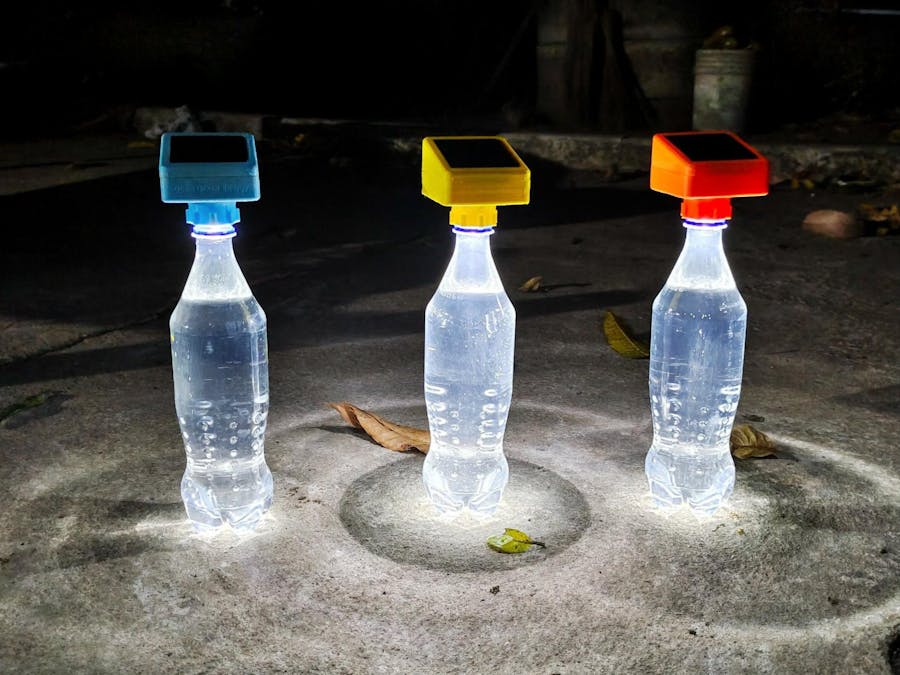Plastic accounts for 85% of marine litter and warns that by 2040, volumes of plastic pollution flowing into marine areas will nearly triple, adding 23-37 million metric tons of plastic waste into the ocean per year. This means about 50kg of plastic per meter of coastline worldwide.
The consequences of the above problem are:
- Plastic pollution threatens food safety and quality, human health, and coastal tourism, and contributes to climate change.
- Marine species ingest or are entangled in plastic debris, which causes severe injuries and death.
The main goal of this project is to reuse the tons of plastic bottles that are thrown into the garbage.
The core concept of the DIY Solar Bottle Lamp has two missions:
1. To prevent waste by making it easy for anyone anywhere to repurpose and upcycle water and soft drink plastic bottles that would otherwise be discarded and further contaminate the planet.
2. to make free solar-powered light available to everyone, whether it is at a remote camping site for outdoors enthusiasts, or at an extremely remote and rural location in any of the most economically challenged countries in the world.
This project is an entry for "Challenge 3: Marine Conservation - Plastic Pollution"
Background:
I designed this lamp by inspired from Moser bottle which was invented by Brazilian mechanic Alfredo Moser. The concept is that clear plastic beverage bottles filled with water and bleach can be fixed into the roof of an unlit building to refract sunlight around a room.
In 2011, Illac Diaz used Moser’s technology to start the Liter Of Light ( MyShelter Foundation), which used a grassroots model to provide lighting on a large scale. The program uses partners around the world to keep costs down, using recycled plastic bottles and locally sourced materials. The program also promotes local entrepreneurs, by providing financial incentives to locals who assemble and install the lights.
The Moser bottle lamp is simple and inexpensive but has a limitation. It only works during the daytime. So I have designed a solar bottle cap that can provide light during the night. By combining the Moser Bottle concept and my Solar Bottle Cap, a powerful lamp can be made.
Benefits:
- Reusing plastic bottles can significantly reduce pollution, greenhouse gas emissions, and energy usage.
- The use of solar lamp will decrease the amount of local air pollution and saves energy.
- It can provide access to solar lamps at an affordable price to a wide range of people living in remote villages that are deprived of clean energy access.
- It also came out as an alternative business model with the potential to strengthen the overall rural economy by generating technology-based livelihood opportunities.
Working Of Moser Bottle:
It works by the refraction of light rays because of different mediums, air, and water. By refracting light from the sun, it produces light 360 degrees around the room with an equivalent light power of 55 watts bulb. It will last for 5 years without maintenance and before the water has to be changed. The chlorine prevents the growth of microorganisms and maintains the clarity of the water.
If you want to know more about it, you may go through a nice research Journal. It is attached in the files section.
Image credit: - believe.earth
How does the Solar Bottle Lamp work?The solar panel receives sunlight from the sun and converts it into electrical energy. The controller board charges the battery during the daytime and drives the LED during the nighttime.
The solar lamp can be considered as a standalone Solar Photo Voltaic (SPV) system and contains four basic components:
1. Solar Panel: Convert Solar Energy to Electrical Energy
2. Controller: Charge the Battery ( Charger ) and drive the Load ( Driver )
3. Battery: Store the Electrical Energy
4. Load (LED): Provide the desired light output
How does the Circuit work ?The entire circuit is broadly dived into 3 parts:
1. Charger Circuit
2. Battery Protection Circuit
3. LED Driver Circuit
The power generated by the Solar Panel is extracted by the charger circuit and charges the battery. The protection circuit is responsible for providing various protections to the Li-Ion Battery. The LED driver circuit is responsible for driving the LED.
Charger Circuit:The charger circuit charges the battery by taking power generated from the solar panel. It is based on a lithium-ion battery charger IC LP4060. It is a complete constant-current/constant-voltage linear charger for a single-cell lithium-ion battery. It uses only a few external components like resistors and capacitors. The circuit is based on the application circuit given in the datasheet.
Battery Protection Circuit :The Battery Protection Circuit provides various protections to the Li-Ion battery. The circuit is based on IC - AP6685 which contains internal power MOSFET, high-accuracy voltage detection circuits, and delay circuits. The IC has the following protections inbuilt:
1. Reverse polarity protection
2. Over Charge Protection
3. Over-Discharge Protection
4. Load short circuit protection
LED Driver Circuit :The LED driver drives the LED as well as controls the brightness. It also provides automatic turning ON during the night. The circuit works as follows
During the day, the solar cell has voltage to D1-diode to bias transistor Q2 it conducting collector and Emitter closed, so it does not have the voltage to the gate of MOSFET Q1. It is OFF so the LED will go out. At the same time, the current from the solar panel will charge the battery.
When there is no sunlight, no solar current to base Q2, So it will not conduct but at the same time, MOSFET Q1 will conduct. Now the battery’s current will flow to LED through the resistors ( R3 or R4 ).
The button switch is used to connect either R3 or R4 in the LED circuit. When the pole is connected to R3, the brightness is Low ( High Resistance, Low LED Current ) and when connected to R4, the brightness is High ( Low Resistance, High LED Current )
PCB Design:I have drawn the schematic by using Fusion 360 Electronics Design after that switched to PCB layout. I have placed all the SMD parts on the top side of the PCB and the button on the bottom side of the PCB. The main reason for placing the button switch on the bottom side is that it will be easier to access from outside of the enclosure. It also reduces the PCB board size.
Download the Gerber files from PCBWay
PCB Assembly:It's very important to first clean the PCB with some isopropyl alcohol. Then apply solder paste on the pads by using a solder paste syringe. Place parts with tweezers making sure that LEDs, chips, etc. are properly aligned. I like having a second board with no paste on it to see the alignment dots.
Now you have many options to cook the PCB like hot air soldering gun, Hot plate, reflow oven, etc. I have used my Miniware MH30 hot plate to solder the PCB. Set the temperature according to your solder paste melting point and place the PCB on the hot plate.
It is important to look at the reflow profiles of all your components, to see how long you can heat your components, and at what temperature. I usually just "wing it", and heat them at about 250C, for about a minute. You will see the solder melting, and the components being soldered into their respective places. Now you can turn off the hot plate and let it cool down completely.
Once you have completed the soldering process it is important to remove the flux from PCB. Spray a small quantity of IPA (Isopropyl alcohol) Solution and clean it with the cotton.
Now the PCB boards are ready to use.
3D Printed Enclosure Design:The enclosure for the solar lamp is designed in Autodesk Fusion 360. I have designed many iterations to get this design. The enclosure has 5 parts:
1. Main Body
2. Top Cover
3. LED Holder
4. Diffuser
5. Button
The Main Body is basically designed to fit all the components including the battery. The top cover is to cover up the main body and mount the solar panel on it. The LED holder is used to hold the LED and the diffuser is used to diffuse the LED light in all directions. The button is used to operate the switch on the PCB from outside.
Download the .STL files from Thingiverse.
3D Printing:I have used my Creality CR-10 Mini printer and 1.75 mm PTEG filaments to print the parts. I have printed itin 3 different colors yellow, Orange and Cyan. The diffuser is printed in a transparent filament. You need asupport structure for printing the main body and top cover.
My settings are:
1. Print Speed: 60 mm/s
2. Layer Height: 0.2mm
3. Fill Density: 25%
4. Extruder Temperature: 235 deg C
5. Bed Temp: 75 deg C
Mount the Solar Panel:You have to use a solar panel that can be fitted to the enclosure. The slot is made for mounting a 60x60mm solar panel. The solar panel that I have used here is rated for 6V and 50mA.
Insert the terminal wires from the solar panel into the slot in the top cover and solder them to the PCB ( SOL+ and SOL-). Mount the solar panel on the top cover by using epoxy glue.
Seal the panel from inside also, so that water will not enter the enclosure.
Install the Battery Terminals:Solder 24AWG wires to the battery terminals. I always prefer to use red wire for the positive terminal and black wire for the negative terminal. The spring shape contact is the negative terminal. Solder the terminal wires to the PCB ( BAT+ and BAT- )
Then install the terminal plates into the battery slots as shown in the above picture.
Mount the LED:I have used an 8mm 0.5W straw hat LED. Solder 24AWG red wire to the positive terminal and black wire to the negative terminal of the LED.
Mount the LED into the holder and then install it into the main enclosure as shown in the above picture. The notch shall be aligned properly.
Now seal the LED from all sides by using epoxy glue. Then install the diffuser, and you can apply epoxy glue to the joint.
Install the Button Cap:Insert the Switch button cap into the slot given in the main body. You have to align the notches perfectly.
Install the PCB:Align the PCB mounting holes with the mounting studs in the enclosure. Then secure it with two M3 screws.
Now solder the terminal wires from LED, Battery, and Solar panels. The polarity is marked on the PCB
After installing all the parts, close the top cover by aligning the mounting studs. For a better joint, a snap and fit arrangement is also provided in the top cover. Now use M3 screws to tighten both the parts together. You may apply epoxy glue at the joints to make it weatherproof.
Now the lamp is ready for use.
Prepare the Bottle:The solar lamp is compatible with any soft drinks bottle cap. Take an empty soft drinks bottle and clean it thoroughly.
Fill the bottle with water and add a few drops of chlorine to avoid algae formation.
Close the bottle with Solar Bottle Lamp and your lamp is ready.
Finishing:Before first use, charge the battery by placing the bottle lamps in bright sunlight for at least a day. Then turn on the button switch to set the desired brightness ( Low / High ). Place the bottle lamp at the desired location like a garden or pathways. The lamp will be automatically switched on when the sun goes down.
If you want to use this lamp for lighting the room, you can follow this Instructables to mount it on the roof.









Comments